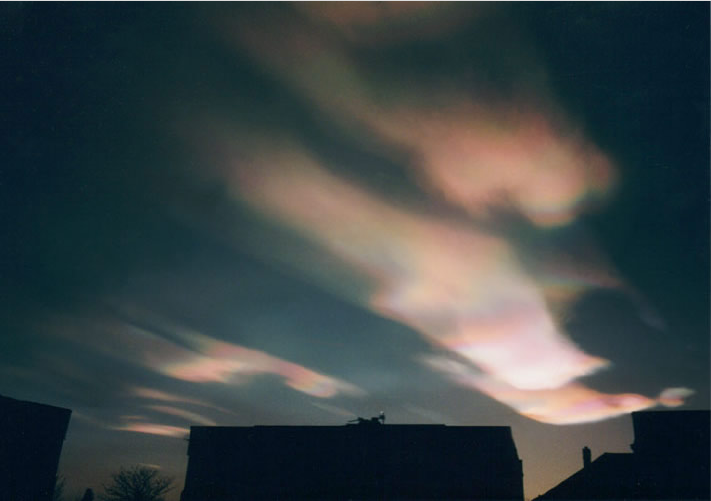Nacreous Clouds
Nacreous Clouds: A Spectacular Atmospheric Phenomenon
Nacreous clouds, also known as polar stratospheric clouds (PSCs), are a stunning and rare atmospheric phenomenon that captivates the eyes of onlookers. These unique clouds, characterized by their vibrant colors and ethereal glow, are typically observed during twilight hours in polar regions. While they may appear delicate and filmy, nacreous clouds are actually found at extremely high altitudes in the stratosphere, where temperatures plummet to frigid levels. In this article, we will delve deeper into the mesmerizing world of nacreous clouds, exploring their formation, characteristics, and the awe-inspiring visual spectacle they create.
Formation of Nacreous Clouds
Nacreous clouds form under specific atmospheric conditions in the polar stratosphere, typically at altitudes of 15 to 25 kilometers (9 to 16 miles) above the Earth's surface. These conditions occur during winter in high-latitude regions such as the Arctic and Antarctic, where the stratosphere becomes exceptionally cold. Temperatures in this region can plummet to below -78 degrees Celsius (-108 degrees Fahrenheit), creating a frigid environment that is conducive to the formation of these unique clouds.
The formation process begins when water vapor freezes onto tiny particles, such as dust or ice crystals, in the stratosphere. The resulting ice particles grow larger as they accumulate more water vapor. What sets nacreous clouds apart from other cloud types is their composition. Unlike lower-altitude clouds that consist primarily of water droplets, nacreous clouds are composed of ice crystals. These ice crystals are responsible for the captivating colors observed in nacreous clouds.
Characteristics of Nacreous Clouds
Nacreous clouds are renowned for their breathtaking display of colors. As sunlight interacts with the ice crystals within these clouds, the phenomenon of diffraction occurs. This process causes the sunlight to scatter and refract, resulting in a stunning array of iridescent hues. The colors observed in nacreous clouds can range from vibrant greens and blues to soft pinks and oranges, creating a mesmerizing spectacle in the twilight sky.
In addition to their vibrant colors, nacreous clouds possess unique physical characteristics that distinguish them from other cloud types. These clouds have a distinctive filmy appearance, resembling thin, transparent sheets or veils. They often exhibit a wavy or undulating structure, with their shape and form constantly evolving as they are influenced by stratospheric winds. Nacreous clouds tend to move slowly and silently compared to lower-level clouds, further adding to their ethereal and otherworldly allure.
Observing Nacreous Clouds
Due to their formation in polar regions and specific atmospheric conditions, nacreous clouds are relatively rare and can be challenging to witness. However, when they do occur, they create a visual spectacle that is truly worth experiencing. To increase your chances of observing nacreous clouds, it is recommended to visit high-latitude areas during winter months when the stratosphere is coldest. Locations such as northern Scandinavia, Alaska, Canada, and Antarctica offer favorable conditions for witnessing these stunning cloud formations.
When searching for nacreous clouds, keep in mind that they are typically visible during twilight hours, before sunrise or after sunset. The low angle of the sun's rays during these times enhances the diffraction of light through the ice crystals, intensifying the vibrant colors of the clouds. Patience and persistence are key when attempting to witness this awe-inspiring phenomenon, as nacreous clouds may appear only sporadically and last for relatively short periods of time.
Scientific Significance
Beyond their visual appeal, nacreous clouds also hold scientific significance. The occurrence of these clouds indicates the presence of specific atmospheric conditions that are associated with ozone depletion. In fact, nacreous clouds play a crucial role in the chemical processes that lead to the destruction of ozone molecules in the stratosphere. Studying these clouds and their formation can provide valuable insights into the dynamics of the Earth's atmosphere and contribute to our understanding of ozone depletion and climate change.
Conclusion
Nacreous clouds are a breathtaking natural phenomenon that enchants those lucky enough to witness them. Their vibrant colors, filmy appearance, and high-altitude location make them a truly unique spectacle in the twilight sky. While they may be rare and elusive, the opportunity to observe nacreous clouds is a remarkable experience that highlights the beauty and complexity of our planet's atmosphere. So, keep your eyes on the polar skies and be ready to be amazed by the mesmerizing display of nacreous clouds.

Nacreous clouds shine brightly in the twilight sky.
Photographed in Leeds, England by Lee Montgomerie and Chris Terran (website) on 16th February 1996.
©Lee Montgomerie and Chris Terran, shown with permission.
This stupendous display on a day of ferocious surface gales was seen over much of England and Scotland. The clouds were even visible again at dawn on the 17th. The brightness and colours shown here are no exaggeration. The film-like clouds were unreal, blazing in the stratospheric sunlight as though internally lit by electrical discharges. As they seemingly unhurriedly sheared and stretched in stratospheric winds, their hues shifted through metallic greens, pinks and blues. Their great height was revealed by their slow silent motion compared to that of ragged dark lower clouds scudding beneath.
Note: this article has been automatically converted from the old site and may not appear as intended. You can find the original article here.
Reference Atmospheric Optics
If you use any of the definitions, information, or data presented on Atmospheric Optics, please copy the link or reference below to properly credit us as the reference source. Thank you!
-
<a href="https://atoptics.co.uk/blog/nacreous-clouds-2/">Nacreous Clouds</a>
-
"Nacreous Clouds". Atmospheric Optics. Accessed on November 26, 2024. https://atoptics.co.uk/blog/nacreous-clouds-2/.
-
"Nacreous Clouds". Atmospheric Optics, https://atoptics.co.uk/blog/nacreous-clouds-2/. Accessed 26 November, 2024
-
Nacreous Clouds. Atmospheric Optics. Retrieved from https://atoptics.co.uk/blog/nacreous-clouds-2/.